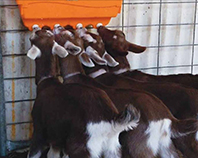Read the latest information on
Foot-and-mouth disease
 For the first time, the newly updated National Kid Rearing Plan is available for goat producers in hard copy, in addition to the online version which can be downloaded from the Farm Biosecurity Program website.
For the first time, the newly updated National Kid Rearing Plan is available for goat producers in hard copy, in addition to the online version which can be downloaded from the Farm Biosecurity Program website.
Animal Health Australia (AHA) worked closely with the goat industry to produce the revised plan, which aims to minimise the risk of infection of kids with Johne’s disease and caprine arthritis encephalitis (CAE) by encouraging producers to employ on-farm biosecurity strategies and control mechanisms.
AHA’s Manager of Endemic Diseases, Lorna Citer, said that the plan was an important tool as both Johne’s disease and CAE were serious conditions that could infect all goat breeds and, once established in a herd, could be challenging to eradicate.
“Unfortunately there is no cure for CAE or Johne’s disease. Instead, prevention and control measures, such as those described in the plan, are the only way to reduce the prevalence of the condition and therefore decrease the significant losses to producers caused by these diseases,” Ms Citer said.
The plan outlines key management practices in the rearing of goat kids and describes points for control to minimise the risk of infections. It focuses on hygienic kid rearing practices similar to those used in the dairy cattle sector, but states that additional approaches such as testing or culling of animals may be required to eliminate these diseases. Supplementary materials to assist with the control of CAE are also included.
“The plan is a free tool that is now available in both hard copy and online versions to make it more accessible to producers. The numerous risk minimisation strategies it contains are the result of extensive consultation between AHA and the goat industry to ensure the plan’s value to all goat producers,” Ms Citer said.
Participation in the plan is voluntary and all goat herd owner and managers are encouraged to use the plan, although it is likely to be of more interest to those breeding or managing dairy goats and other intensively run goats. However, compliance with all elements of the plan, including audits, can allow producers to gain additional assurance rating points on the National Goat Health Statement for Johne’s disease.
Producers and goat health advisors and providers can obtain a hard copy of the National Kid Rearing Plan by completing the order form. Please note that quantities are limited. Alternatively, click here to download an electronic copy.